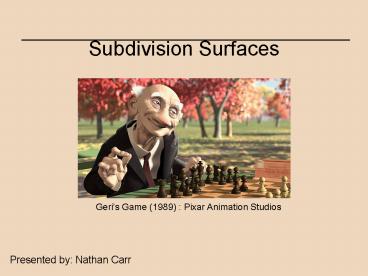Subdivision Surfaces - PowerPoint PPT Presentation
1 / 26
Title:
Subdivision Surfaces
Description:
Subdivision Surfaces. Presented by: Nathan Carr. Geri's Game (1989) : Pixar Animation Studios ... Joe Warren, Henrik Weimer. ( 2002) **Math works out except at ' ... – PowerPoint PPT presentation
Number of Views:175
Avg rating:3.0/5.0
Title: Subdivision Surfaces
1
Subdivision Surfaces
Geris Game (1989) Pixar Animation Studios
- Presented by Nathan Carr
2
Subdivision Surfaces
- Approach Limit Curve Surface through an Iterative
Refinement Process.
3
Subdivision in 3D
- Same approach works in 3D
4
Goals of Subdivision Surfaces
- How do we represent curved surfaces in the
computer? - Efficiency of Representation
- Continuity
- Affine Invariance
- Efficiency of Rendering
- How do they relate to splines/patches?
- Why use subdivision rather than patches?
5
Types of Subdivision
- Interpolating Schemes
- Limit Surfaces/Curve will pass through original
set of data points. - Approximating Schemes
- Limit Surface will not necessarily pass through
the original set of data points.
6
A Primer Chaikens Algorithm
7
3D Surfaces Loop Subdivisions
- Works on triangular meshes
- Is an Approximating Scheme
- Guaranteed to be smooth everywhere except at
extraordinary vertices.
8
Loop Subdivision Masks
9
Loop Subdivision Boundaries
- Subdivision Mask for Boundary Conditions
Vertex Rule
Edge Rule
10
Subdivision as Matrices
- Subdivision can be expressed as a matrix Smask of
weights w. - Smask is very sparse
- Never Implement this way!
- Allows for analysis
- Curvature
- Limit Surface
Smask Weights
Old Control Points
New Points
11
What About Continuity and Curvature..
- Subdivision mask weights w are derived from
splines, such as B-Splines. - Subdivision surfaces converge to spline surfaces
with C2 continuity everywhere. - Too lengthy to cover here, but there is lots of
literature. - Subdivision Methods for Geometric Design
- Joe Warren, Henrik Weimer. (2002)
- Math works out except at Extraordinary
Vertices. Most Subdivision Schemes have and
ideal valence for which it can be shown that
the limit surface will converge to a spline
surface.
12
Ordinary and Extraordinary
Catmull-Clark Subdivision Valence 4
Loop Subdivision Valence 6
- Subdividing a mesh does not add extraordinary
vertices. - Subdividing a mesh does not remove extraordinary
vertices. - How should extraordinary vertices be handled?
- Make up rules for extraordinary vertices that
keep the surface smooth.
13
Subdivision in a production environment.
- Traditionally spline patches (NURBS) have been
used in production for character animation. - Difficult to control spline patch density in
character modelling.
Subdivision in Character Animation Tony Derose,
Michael Kass, Tien Troung (SIGGRAPH 98)
(Geris Game, Pixar 1998)
14
Catmull-Clark Subdivision (1978)
15
Modeling with Catmull-Clark
- Subdivision produces smooth continuous surfaces.
- How can sharpness and creases be controlled in
a modeling environment? - ANSWER Define new subdivision rules for
creased edges and vertices.
- Tag Edges sharp edges.
- If an edge is sharp, apply new sharp subdivision
rules. - Otherwise subdivide with normal rules.
16
Sharp Edges
- Tag Edges as sharp or not-sharp
- n 0 not sharp
- n gt 0 sharp
- During Subdivision,
- if an edge is sharp, use sharp subdivision
rules. Newly created edges, are assigned a
sharpness of n-1. - If an edge is not-sharp, use normal smooth
subdivision rules.
IDEA Edges with a sharpness of n do not get
subdivided smoothly for n iterations of the
algorithm.
17
Sharp Rules
FACE (unchanged)
18
Non-Integer Sharpness
- Density of newly generated mesh increases
rapidly. - In practice, 2 or 3 iterations of subdivision is
sufficient. - Need better control.
- IDEA Interpolate between smooth and sharp rules
for non-integer sharpness values of n.
19
Local Subdivision Schemes
- Complex data structures required to perform
subdivision. - Every polygon ( triangle, quad, ..) must know its
neighbors - Every vertex must know its neighbors
- Can we do something simpler?
- Use vertex normal information to help guess
about neighboring polygons. - Subdivide based on the normals.
subdivision
20
PN Triangles
- Interpolating Scheme.
- Example..
21
Local Subdivision (PN triangles)
- Defined from triangular bezier patches.
u,v,w are barycentric coordinates w1-u-v, u,v,w1
Bezier basis function
Curved PN Triangles Alex Vlachos Joerg
Peters Chas Boyd Jason Mitchel
22
Computing the Control Mesh
23
Local Subdivision
- Advantages
- Easy to implement
- No complex data structures
- Easy to integrate into existing graphics
applications - Hardware amenable
- ATI Radeon 8500
- Looks good
- Disadvantages
- No guarantees on higher level continuity.
- Is limited in the amount of curvature it can
provide. - In some sense it is a hack and not as correct.
24
Adaptive Subdivision
- Not all regions of a model need to be subdivided.
- Idea Use some criteria and adaptively subdivide
mesh where needed. - Curvature
- Screen size ( make triangles lt size of pixel )
- View dependence
- Distance from viewer
- Silhouettes
- In view frustum
- Careful! Must ensure that cracks arent made
crack
subdivide
View-dependent refinement of progressive meshes
Hugues Hoppe. (SIGGRAPH 87)
25
Subdivision Surfaces for Compression
?
(Refinement)-1
Progressive Geometry Compression Andrei
Khodakovsky, Peter Schröder and Wim Sweldens
(SIGGRAPH 2000)
26
Conclusions and Future Work
- Currently there is no standard data structure for
handling (Non-Local) Subdivision Surface schemes - Hardware (GPU) implementations do not exist
- Subdivision of higher dimensional surfaces































